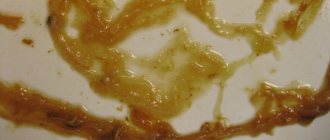A woman's body can produce special mucus that moisturizes and cleanses the vagina. This is a natural phenomenon that cannot be avoided. After all, it is this substance that removes dead cells, menstrual blood, mucus, and various microorganisms from the body.
The components of yellow discharge from the female body are mucus and liquid entering it from the vessels. If the abundance of discharge is within normal limits, it will disappear on its own after two or three days, without causing the woman any discomfort.
If yellow, odorless discharge appears in a representative of the stronger sex, this means that he has some kind of urogenital pathology. If a man notices this phenomenon, he should consult a doctor - a urologist or andrologist. In a healthy male body, there is no excessive discharge from the genitals.
Yellow discharge without odor
If a man is sexually aroused, a little lubricant may come out of his penis. However, this discharge usually disappears soon after sex. It is not so rare that yellow mucus is released as a result of the development of sexually transmitted pathologies. So the man who notices it is best to visit a venereologist to find out where the disease came from.
Why does odorless yellow mucus appear?
It has been established that a woman can experience this same discharge for any of the following reasons:
- age-related changes causing hormonal imbalances;
- period before menstruation;
- an abortion, a miscarriage;
- preparing the body for childbirth, which is about to begin;
- consequences of recent childbirth;
- different stages of pregnancy - in some women;
- active use of hormonal contraceptives - snot-like, odorless discharge;
- the period of menopause at an older age;
- use of synthetic underwear;
- active use of condoms (during sex), pads, tampons, hygiene products;
- stress that disrupts the psycho-emotional background, which can cause allergic reactions, including the secretion of mucus.
In women, yellow, odorless discharge can appear for many reasons.
On the eve of menstruation
Before menstruation, a woman's estrogen production increases sharply. Examples of consequences:
- emotional swings;
- odorless discharge;
- prostration;
- dizziness;
- increased fatigue.
Yellow discharge that appears before menstruation is not a sign of pathology
In the absence of a delay in the critical days, mucus sometimes begins to be released a week or two before menstruation. If the body is normal, the following symptoms never occur:
- clots, whitish streaks in the discharge;
- burning;
- itching;
- pain;
- unpleasant smell.
If the body is normal, then the woman does not experience any discomfort
Here are examples of pathologies that are characterized by similar symptoms:
- hormonal imbalances;
- erosion;
- fibroids;
- neoplasms;
- cysts;
- allergies to anything;
- inflammatory processes;
- colpitis
Colpitis
Important ! If odorless discharge with a green tint appears, a woman is advised to consult a specialist for advice. If the mucus changes color, this may be a signal of dangerous diseases of the reproductive system.
After menstruation
This symptom may well be a signal that something is wrong with the body. The body, weakened by the monthly female problem, is relatively vulnerable to pathologies. On the other hand, diseases are only one of the possible causes of discharge after menstruation.
Yellow, odorless discharge after menstruation in women can become a sign of pathologies of the reproductive system
Important ! At such a time, particles of vaginal microflora are still released from the body. It is because of them that the mucus has a yellowish color. Here a woman should not panic, because now it is known that this is natural.
Here are examples of symptoms that you should still be wary of:
- severe burning sensation;
- pain in the lower abdomen;
- severe itching;
- pain during intimacy;
- pain flowing into the lower back.
These symptoms mean the need to immediately visit a gynecologist. He will conduct a diagnosis to find out why the discomfort began. Next, the doctor will develop a drug treatment regimen for a specific patient to eliminate all symptoms.
If a woman experiences severe burning and itching in the external genital area, you should be wary
Inflammation of the genital organs
When the infection ends up in the female genital organs, the body begins to secrete a lot of yellow mucus. Moreover, the color and intensity of the discharge have different variations. Here are infections that cause a similar symptom:
- salpingitis. Sometimes there may be blood in the discharge. Due to the spread of infection to the bladder, it becomes painful to empty;
- adnexitis. With it, pus appears in the mucus. Emptying your bladder and having sex becomes painful. The same goes for periods;
Adnexit
- bacterial vaginitis (vaginal inflammation). A lot of foul-smelling mucus is secreted;
- some venereal pathologies. The discharge is copious and foul-smelling. Contains pus. Due to irritation of the genital organs, swelling, itching, and burning occur.
A symptom of inflammation of the genital organs may be yellow discharge
Urethritis in men
Yellow discharge in a representative of the stronger sex means that there is inflammation in the body. At the same time, there is a lot of pus in the mucus. This symptom is quite typical, among other problems, for specific urethritis. Inflammation in the urethra can be caused by sexually transmitted pathologies.
Nonspecific urethritis is caused by opportunistic microorganisms such as fungi and cocci. They are present even in a healthy male body. However, a decrease in the immune response provokes their pathogenic activity.
With urethritis, men may also experience yellow discharge
Curdled discharge
If you have yellow, cheesy discharge, a woman should not try to get rid of it on her own, otherwise it will only make things worse: it will provoke unpleasant complications. It is recommended to consult a doctor here. He will be able to explain why odorless yellow discharge occurs, as well as when it is not a symptom of any infections.
Curd-like yellow discharge occurs in both men and women
Usually, cheesy, odorless discharge appears due to infections - specific or purulent. The cause may be the development of the following infections.
| Disease | Description |
| Trichomoniasis | The discharge is copious and thick. This pathology, if not treated on time, can become chronic. The disease develops due to a pathogenic microorganism that usually enters the body through unprotected intimacy. It has recently been proven that household contacts also cause infection with trichomoniasis. Then the sick person's mucus is yellow-green, gradually becoming foamy. At the same time, the woman feels severe itching and burning, and the vaginal mucosa is irritated. |
| Gonorrhea | At the beginning of the development of this disease, a woman may secrete a yellow, cheesy mass. Then they become purulent and have an unpleasant odor. |
| Chlamydia | This pathology occurs due to a bacterium called chlamydia. Chlamydia enters the reproductive system during sex. Rarely, you can become infected through everyday activities. With this pathology, curdled mucus with large clots flows from the woman’s cervical canal. If treatment is not started or time is missed, the infection can spread to the urethra, as well as to the rectum. |
| Ureaplasmosis | Pathogenic microorganisms are found on the mucous membranes of the genitourinary system. |
This problem can occur with ureaplasmosis
Curdled discharge is common among women who have had an abortion. Moreover, this can last for several months. Until the consistency of the mucus returns to normal, the woman should carefully monitor the shade and structure of the discharge. At the slightest change, it is important to immediately consult a doctor for diagnosis and advice. Doctors can often accidentally introduce an infection while doing curettage.
Important ! If blood appears in the cheesy discharge, you should consult a doctor as quickly as possible. This is a symptom of the presence of neoplasms in the organs of the reproductive system. And these same neoplasms can be extremely dangerous.
If odorless yellow cheesy masses appear with blood after menstruation, you should also quickly consult a specialist. After all, this could be a symptom of an ectopic pregnancy or other dangerous pathology. After conducting the necessary research, doctors will find out where the discomfort came from, and then prescribe the appropriate treatment.
If drops of blood are observed in the discharge, you should immediately consult a doctor.
Normal discharge
A significant number of women are bothered by yellow vaginal discharge. This is due to the fact that the shade of the discharge is predisposed to a natural shade and, on the contrary, talk about severe processes of inflammation, infections inside the vagina, spread through sexual intercourse.
The entire female half of society should learn to understand their secretions, when they are naturally yellowish in color, and where they are combined with pathological processes.
Experts prove that the fluid released from the vagina has normal colors - clear and white. This discharge is called leucorrhoea. It happens that discharge that is white takes on a yellow tint and is not associated with any inflammation. The basis for such changes are changes in hormones, the use of contraceptive drugs, and stressful situations.
When the discharge has no odor, it does not cause discomfort, and there is no itching, burning, or pain, then it is a natural shade of leucorrhoea. When these symptoms are disturbing, it means that an infectious inflammation has appeared, which passes during sexual intercourse and the inflammatory process.
It is considered natural that when, after sexual intercourse, the sperm remaining in the woman’s vagina is excreted in the form of yellowish clots.
Before menstruation, during pregnancy, during the period of ovulation, in a larger percentage of the female half, the excreted volume does not exceed the usual amount by much. It is worth paying due attention to the fact that when you are pregnant, you will need to be more careful about such changes, because the expectant mother’s body is significantly prone to infection during this period.
In what cases should you be wary?
The mucus that flows out may vary in color. It is determined by how severe the pathology is, as well as by where the inflammation in the urethra came from. The discharge contains cells, mucus and fluid. If there are many cells per unit of secretion, they become cloudy. With a strong concentration of leukocytes, the discharge turns yellow or green. In men, candidiasis usually causes a thick, thick white discharge. It’s easy to notice this when looking at panties.
You should be wary if discharge begins to appear more often
Yellow discharge may occur due to cancer of the urinary tract or genital organ. Due to the progression of cancer, the urethral mucosa often becomes covered with ulcers, and the organ becomes inflamed. Then blood sometimes gets into the mucus.
Often the discharge in representatives of the stronger sex is abundant, and it comes “complete” with pain in the urethral area. However, things may go differently. Many men secrete mucus only in the morning, after they have not gone to the toilet for a long time.
If the discharge is not accompanied by pain, then there are no pathologies
To identify the cause of this problem, they resort to the following diagnostic techniques:
- visual examination of the penis and perineum, which is necessary in order to detect or exclude injuries to the penis, rash, and inflammation;
- palpation of the lymph nodes in the groin. Temperature of the surrounding tissues, their dimensions, density, presence/absence of ulcerations, mobility/adhesion to the skin;
- digital examination of the prostate gland;
- smears for culture, microscopic examination, PCR;
- Ultrasound of the kidneys, bladder, prostate;
- blood tests;
- Analysis of urine;
- urography;
- CT.
In case of strong discharge, examination by a gynecologist or urologist is necessary.
Important ! You should prepare for diagnosis ahead of time. This means that in the 72 hours preceding the procedures, you should not use antibiotics, antiseptics, or anti-fungal medications.
In most cases, the doctor does not prescribe medications until the examination is completed. However, severe forms of acute pathologies are the reason for prescribing antibacterial drugs with a wide range of use. After receiving the diagnostic results, the specialist will prescribe other remedies.
Diagnostic methods for discharge. Treatment options
- During the examination, the gynecologist takes a smear from the genital organs for laboratory tests, which make it possible to understand whether the vaginal microflora is normal and whether there are any infectious diseases.
- An ultrasound of the pelvic organs is prescribed to assess the condition of the internal genital organs, the uterus, its endometrium, and the ovaries.
- Be sure to get tested for STDs, since an untreated infection can lead to serious complications.
The examination will cost from 2000 rubles.
To treat many gynecological problems associated with yellow discharge, you do not need to go to the hospital. Patients successfully get rid of unpleasant symptoms at home, following all the recommendations and instructions of the gynecologist.
As a rule, vaginal suppositories, tablets and creams are prescribed that restore healthy vaginal microflora, as well as antibiotics, which are selected strictly based on test results. Many infectious agents are sensitive only to certain groups of antibiotics; a course of treatment with incorrectly selected drugs can not only be ineffective, but also cause harm to health.
For example, in the treatment of trichomoniasis, metronidazole and tinidazole are prescribed, and in the treatment of infections caused by chlamydia, other drugs are used - doxycyline or azithromycin.
When treated with antibiotics, medications are additionally prescribed to enhance immunity and improve the body's resistance. Surgery is usually not required. The sexual partner should also undergo treatment at the same time. During menopause, the doctor may prescribe hormonal drugs, under the influence of which the vaginal mucosa returns to normal.
Recommendations
If you are concerned about yellow but non-odorous discharge, you need to make an appointment with a gynecologist, who can provide advice. The doctor will find out the reasons for the odorless discharge. The specialist will describe the situations when, at the beginning of the critical days, yellow, odorless mucus comes out. He will also advise what to do to protect the body from pathogens, as well as from the results of its effects.
Even if yellow discharge appears infrequently, an examination by a gynecologist will not be superfluous.
To prevent diseases that cause bright yellow, odorless discharge, a woman must follow certain safety measures:
- intimate intimacy only with trusted men;
- sex - only protected;
- panties made exclusively from natural materials;
- avoiding scented personal care products;
- timely treatment of illnesses;
- Seeing a doctor to combat hormonal changes.
The discharge is yellow and odorless. Is there any reason to sound the alarm?
The presence of clear yellow discharge does not always mean the presence of any pathology. Pale and scanty mucous formations are considered normal. Even brighter yellow discharge can be considered normal if it occurs on the eve of your period.
There is no need to sound the alarm without unnecessary reasons. Inflammatory processes, in addition to the pronounced yellowness of the discharge, are usually accompanied by a specific odor, pungent and unpleasant. During infection, the discharge also becomes more abundant, and the genitals and the skin around them become covered with a reddish irritation, causing discomfort.
Yellow vaginal female secretion is a fluid that comes from the mucus that flows down the cervix and the blood vessel system. Such discharge, which is considered normal, does not cause inconvenience, has no odor and disappears on its own after a couple of days.
The main thing is that when this kind of discharge appears, carefully follow hygiene procedures to avoid the occurrence of rashes and unpleasant irritation in the intimate area.
The reasons for the occurrence of such discharge include:
- an increase in the total volume due to the rapid onset of menstruation, a few days before birth or within a few days after birth;
- changes in a woman’s hormonal levels due to age-related characteristics;
- active use of hormonal contraceptives;
- presence of stressful situations;
- changing the usual means for intimate hygiene, pads, tampons and condoms, can also cause the appearance of questionable discharge;
- the body may react to synthetic underwear with yellow discharge;
- Negative factors for the occurrence of yellow discharge include the possible presence of diseases of the mammary glands.
Therapy
A man will be able to stop discharge from gonorrhea, as well as minimize the risks of complications, only if he takes antibacterial medications.
Healthy diet
The patient must watch what he eats. It is impossible to make therapy effective without vegetable juices, salads with herbs, as well as fruits and berries, and all this plant food must be fresh. It is equally important not to consume anything pickled, spicy seasonings, or alcohol.
To get rid of this problem, you need to reconsider your diet.
ethnoscience
Pathologies of the genitourinary system, which cause yellow discharge, are treated with both folk remedies and traditional ones. A man is recommended to use the following recipes:
- drink 0.2 liters of viburnum juice daily. Viburnum berries are also used in medicinal decoctions. Use for thirty days;
- Take 0.1 liter of yarrow decoction four times a day. Therapy with yarrow decoction should be carried out for 14 days.
Traditional medicine can get rid of this problem
If the yellow discharge is small enough, an infusion of black currant leaves is useful. Take 20 g of leaves, pour 0.4 liters of boiling water. Use 0.1 liter of the product three times a day. The berries of the same plant are also useful: they are a natural anti-inflammatory and diuretic drug, which is the raw material for medicinal infusions and decoctions.
More folk remedies:
- Pour boiling water (200 ml) over cornflower flowers (10 g), leave for an hour, strain. Drink (20 ml) three times a day before meals;
- pour sedge root (20 g) with boiling water (600 ml), heat for 10 minutes over low heat, leave for a couple of hours or more. Drink (70 ml) for a month or more, four times a day;
- pour boiling water (200 ml) over burdock root (10 g), leave for 20 minutes, strain. Drink (10 ml) three times a day.
You can eliminate the appearance of discharge using burdock
The last recipe has almost no contraindications. Burdock is a strong antiseptic, but there is still one contraindication. This is an individual sensitivity.
Important ! Before using folk remedies, you should consult a specialist. If a “side effect” appears, use must be interrupted.
Yellow discharge may mean that something is wrong with the genitourinary system. To identify what exactly is their cause, the use of a variety of diagnostic techniques is required.
Before using folk remedies, you should consult your doctor
Preventive measures to prevent yellow vaginal discharge
Now that we have identified the main causes of yellow vaginal mucus, we must turn to preventive measures. In addition to certain feminine hygiene rules, there are some other important factors to keep in mind to keep your intimate area clean and avoid many unpleasant situations. Listed below are basic preventative measures that you should consider carefully.
Rely on water and mild soap to clean
While normal vaginal discharge can keep the vagina clean and rid of bacteria as well as dead cells, you still need to be careful about your personal hygiene. Avoid scented soaps, body milks, perfumes and deodorants, and rely mostly on plain water to remove dirt and freshen your intimate area. If you use any soap, try to choose a very mild soap that is pH neutral to avoid damaging your vaginal pH. Also, don't clean your genital area too often, or you may cause an imbalance in the vaginal flora, which can lead to bacterial vaginosis.
Take a shower, not a bath
Nothing will help you relax and soothe your mind and body after a busy day than a hot bath with essential oils and bubble bath. But as desirable as they may be, these baths can actually lead to light yellow vaginal discharge. Spending a few minutes in the bath will fill the water with bacteria from your skin, which can enter your intimate area and cause a urinary tract infection. Take showers instead of baths to avoid this and also effectively clean the genital area.
Wear only cotton underwear
While sexy lingerie can make you look very attractive, it can also change the color, consistency, and smell of your discharge. Experts recommend wearing specifically 100% cotton underwear as it will be more breathable, allowing your skin to breathe and preventing infections. If possible, change your underwear twice a day to prevent bacteria from coming into contact with your private parts.
Avoid dampness in the genital area
Humidity can create an ideal environment for bacteria to grow, which can lead to bacterial vaginosis and vaginitis. Thus, you should avoid dampness in the genital area at all costs. Change your underwear after exercise and remove your swimsuit as soon as possible to prevent bacterial overgrowth.
Always wipe from front to back
Many women do not understand the importance of proper wiping when using the toilet. Always wipe from front to back to prevent bacteria and dirt from the anal area from moving into the vaginal area, which can lead to a urinary tract infection. Washing your hands before and after using the toilet will help remove bacteria from your skin so it doesn't transfer to your genitals. Ultimately, be sure to use unscented toilet paper and pH-neutral baby wipes to avoid altering your vaginal pH.
Maintain a healthy diet
Very few women actually connect their eating habits with how healthy their genital area is. Eating a balanced, healthy diet and drinking plenty of water is essential for reproductive health. Cranberry juice and yogurt can actually help treat yeast infections by preventing the overgrowth of Candida albicans. Probiotics and prebiotic supplements will also keep the growth of certain types of yeast under control to prevent infections. Eat as many vegetables and fruits as possible and try to avoid foods that are very rich in fats, carbohydrates and other such harmful substances.
Practice safe sex
The key to reproductive health is to never have unprotected sex. Avoid multiple sexual partners, which may increase the risk of contracting sexually transmitted diseases and yellow, odor-bearing vaginal discharge. Always use condoms and get tested regularly to make sure you are free from STDs.
Results
If a woman’s yellow discharge does not smell of anything, there is no burning or itching from it, there is no pain or frequent urge to go to the toilet for “minor needs,” then she should not worry about it. A woman’s yellow discharge, in the normal state of her body, disappears on its own, and this happens very quickly. Before menstruation, the volume of mucus secreted by the body may increase. But overly bright and cheesy discharge is already a reason to be wary. The presence of lumps, blood or a heterogeneous structure in them all the more means the need to urgently visit a doctor.
Frequent yellow discharge is a sign of pathology
Reasons for suspicion that the hormonal balance is disturbed or the genitals have been subjected to the destructive effects of infection are the following features acquired by the secretions:
- change in shade and consistency;
- foamy structure;
- unpleasant odor;
- strong density.
Important ! If these signs occur, you should urgently make an appointment with a gynecologist, who will take smears and prescribe all the necessary examinations. And if there is a suspicion of a tumor, he will be able to use special techniques for the same purposes.
Causes of discharge in healthy patients
Yellow discharge does not necessarily signal any pathology. There is a mucous layer in the vagina and cervix. It contains a large number of glands, from which a mucous secretion is secreted.
The vaginal microflora is a special and delicate environment for the female body. The composition and condition of the vaginal flora largely depends on the age of the woman, the process of the menstrual cycle, the functioning of the immune system and even climate conditions.
To maintain a normal and healthy environment, it is necessary to regularly observe hygiene measures and monitor the quality of the underwear used. After all, the fragile microflora of the vagina requires careful care. It is populated by various bacteria, microorganisms and fungi, which provide protection to the walls of both the uterus and the vagina itself from negative environmental factors that are pathogenic in nature.
Any vaginal discharge is an absolute norm in the functioning of the female body. It is thanks to them that the female genital organs are protected and are able to undergo cleansing processes.
Any attempts to eliminate the appearance of mucous discharge, especially on your own - without medical advice, not only make no sense, but also carry a certain health risk.
The complete absence of mucous secretions indicates a disruption of the protective layer, which increases the risk of various infections entering the vagina.
The secreted mucus, the amount of which may vary depending on the stage of the cycle, maintains the normal state of the microflora. The first discharge appears in adolescence with the onset of the first menstruation. But before the start of menstruation, girls should not have any discharge.
Otherwise, the presence of mucus before puberty is a reason to consult a gynecologist, since such manifestations may indicate pathological conditions of the body or infection with subsequent inflammatory processes.
The normal composition of mucus is the presence of coccal bacteria, fungi and even viruses, which are absolutely harmless, but in an unfavorable environment they acquire the ability to actively reproduce, which leads to the formation of inflammation.
Thus, the selections include:
- Mucus that fills the cervical canal - it is secreted from the glands attached to the cervix and performs a protective function; cellular epithelium of the uterus - epithelial cells are capable of constant renewal, while old ones, gradually descending into the vaginal cavity, are excreted from the body.
- Microorganisms - this component of mucus is represented by a cluster of various bacteria, lactic acid and coccal, as well as special acidophilus Dederlein bacilli and plasma - myco- and urea-, in small quantities.
- The presence of pathogenic bacteria may also be possible, but in the absence of inflammation, their number remains unchanged, which eliminates the risk of any complications.
According to gynecologists, the normal discharge rate in a completely healthy female body should be scanty, colorless (transparent) and not have a specific odor. But due to the physiology of each individual woman, yellow discharge may appear.
Changes in the typical color of the discharge indicate the beginning of the inflammatory process. Such changes in the body are a kind of signal to consult a gynecologist, but in no case should you engage in self-diagnosis.
Sometimes, the symptoms of different diseases alternate with each other, so it is easy to confuse the signs of diseases, based only on changes in the color of vaginal discharge.
Pathology
- An infection transmitted to each other through sexual contact is trichomoniasis.
- The predominance of bacterial infection in the acute phase, for example, adnexitis, salpingitis - there is an infection on the uterine tubes.
- The cervix is affected by erosion, the course of adnexitis and salpingitis is chronic.
- The disease gonorrhea is represented by yellow purulent discharge, which has a bad odor, a burning sensation in the genitals and itching, and the volume of discharge is significant.
Pathologies of an infectious nature that occur during sexual contact are awakened by various microorganisms. They contribute to the process of inflammation, burning, and discomfort. Trichomoniasis is quite common.
Trichomonas
Trichomoniasis is an infectious disease. During its penetration into the body, foamy, copious discharge appears. They have a yellow-green color and a pungent odor. The disease is also accompanied by severe burning, itching of the genitals, and irritation. During this period, the woman knows for sure that this is not normal discharge, and the success of treatment depends on the timeliness of seeing a doctor.
Gonorrhea
This is a disease in which the vagina discharges a moderate amount of yellowish-white fluid and has a bad odor. Often during this infection, severe aching pain is felt when emptying the bladder, the stomach hurts, and blood may leak. Discharge is often accompanied by symptoms of adnexitis and salpingitis.
Candidiasis
Thrush is a thick, profuse discharge from the genitals. They resemble curd lumps of white or yellowish color. Thrush causes severe itching, redness, and swelling of the vagina.
All women have “good” bacteria in their vagina. Due to their vital activity, microflora and acidity are maintained at the required level, and the body is protected from infections. Often, the quantitative composition of bacteria can change due to poor intimate hygiene, metabolic disorders, etc., which leads to the proliferation of candida, or thrush, as well as vaginosis.
Vaginosis
In a patient with vaginosis, the discharge is abundant, has a gray-white tint, there is a bad smell (rotten fish), the itching of the genital organs on the outside is slight, and appears from time to time. Symptoms intensify after sex. Long-term prevalence of the disease is characterized by sticky discharge, which has a yellow-green tint.
During the examination, the doctor will see an even distribution of discharge on the walls of the vagina. Vaginosis poses a threat to a pregnant woman, possibly fetal rejection or premature birth. Bacteria, passing into the uterus, can cause an inflammatory process in its mucous membrane.
Yellow leucorrhoea after abortion
Artificial termination of pregnancy can provoke the appearance of yellowish thick discharge. They usually last 3-4 months. The presence of blood impurities in leucorrhoea is due to injury to small vessels. In such situations, you should carefully monitor changes in the odor and shade of cervical mucus. This will allow the development of possible inflammation to be identified at an early stage. The reason for the penetration of streptococcal and staphylococcal infections into the genitourinary system is a decrease in protective functions against the background of an abortion.
Diagnostics
When yellow discharge of a pathological nature appears, a comprehensive diagnosis is carried out, consisting of visual, instrumental and laboratory research methods. The diagnostic search is aimed at determining the focus of the inflammatory or infectious process.
At the initial stage of the study, a gynecological examination is performed at an appointment with an obstetrician-gynecologist. Using this diagnostic method, the condition of the external genitalia is assessed, the walls of the uterus are examined using a gynecological speculum, and smears of cervical fluid are taken for further examination.
The examination allows us to identify destructive and inflammatory processes and helps determine the choice of further diagnostic methods. Instrumental studies allow us to give a more detailed assessment of the functioning of the pelvic organs.
These include:
- Transabdominal ultrasound is a superficial ultrasound examination that is performed to examine the condition of the uterus, folic tubes and ovaries. During external ultrasound, the area in the lower abdomen is lubricated with a special gel, which ensures contact of the device’s sensor with the body. Sensors transmit a dynamic image of the tissues of the organ under study to the monitor screen, from where the necessary information is read. The average cost of the method is from 1000 rubles.
- Transvaginal ultrasound – ultrasound examination, which is carried out through the vagina using a special vaginal sensor. This diagnostic method has a higher degree of accuracy and information content compared to superficial ultrasound. Cost – from 1500 rubles.
- Laparoscopy – examination of the pelvic organs using an endoscope, which is inserted into the anterior abdominal wall after making an incision. The method is indicated for use in cases of ineffective therapy for patients with acute inflammation of the appendages. Cost – from 20,000 rubles.
Laboratory tests consist of smear bacterioscopy, serological reactions, as well as clinical and biochemical blood tests.
Bacterioscopy of cervical fluid smears - study of biological material under a microscope. A smear is taken from the mucous membrane of the vagina, urethra and cervix. The material is collected using a special plastic spatula, and then applied to glass slides and sent to the laboratory. Cost – from 400 rubles.
Serological testing is a method that allows you to study certain antibodies or antigens in the blood serum based on immune responses. Serological reactions are used to diagnose urogenital chlamydia, which causes the appearance of yellow discharge. Whole venous blood is used for the study. Cost – from 650 rubles.
Treatment at home
Treatment of yellow discharge in women at home involves complex therapy. Traditional medicine and medications are used. Before starting treatment, you should consult your doctor.
Therapeutic rules:
| Rule | Description |
| Normalization of nutrition | This is the first step on the road to recovery. You should avoid eating fatty foods and canned foods. If you have candidiasis, you must completely avoid any foods that contain sugar. |
| Hygiene | A woman needs to wash herself 2 times a day. Compliance with hygiene rules will normalize the vaginal microflora. |
| Normalize sleep patterns | You need to go to bed at sunset. Nighttime wakefulness leads to the development of diseases of the endocrine system, causes lack of rest, overwork and deterioration of the immune system. |
Traditional medicine recipes:
| Means | Description |
| Pine needle baths | Add 150 g of dry pine to 3 liters of water. It is necessary to use bark, trunk or branches with fresh needles. Cook for 40 minutes over low heat. It turns out a light antibacterial extract for taking baths |
| Nettle juice | Take a dessert spoon 3 times a day. Helps reduce pain associated with yellow discharge or menstruation |
| Decoction for douching | Add a tablespoon of blueberry leaves to a glass of boiling water. Boil for 15 minutes. Filter and cool before use. Use 1 time per day |
| St. John's wort | A tablespoon of dry herb per 1 liter of boiling water. Cook for 30 minutes over low heat. Strain through cheesecloth and use for douching |
To boost immunity, doctors recommend taking vitamins. It is useful to include vitamin C, B6 and B12 in treatment.
Drug therapy:
| Group | Drugs, description | Photo |
| Antifungal | Pimafucin, Candide, Kanison, Mycozon. Available in the form of tablets and ointments. For the treatment of vaginal candidiasis, the priority is to use topical agents. The drugs act on fungal cells, inhibiting their development and reproduction | |
| Antibiotics | Pancef, Amoxicillin, Miramistin, Amosin. Antibacterial drugs suppress the activity of not only pathogenic microflora, but also neutral ones. Dysbacteriosis is one of the reasons for the development of candidiasis, so long-term use of antibiotics should be accompanied by antifungal medications | |
| Antiviral | Altevir, Arbidol, Valtrex, Ingavirin. All antiviral drugs are prescribed by a doctor after examination and diagnosis. Antivirals should be taken with caution during pregnancy and breastfeeding, since these medications are highly toxic |
Source: fraumed.net











